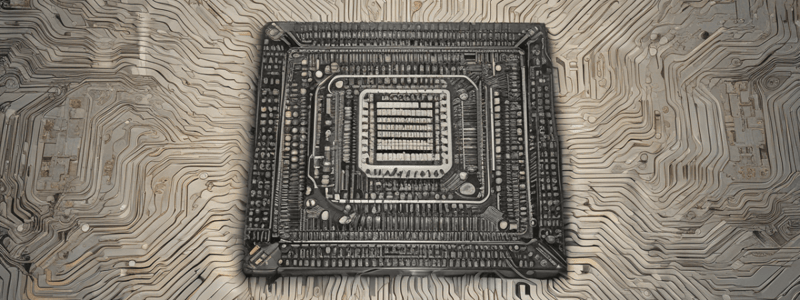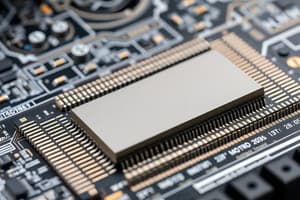Podcast
Questions and Answers
What is the primary issue with the accumulator architecture?
What is the primary issue with the accumulator architecture?
- It has an intrinsic performance problem. (correct)
- It cannot perform multiplication operations.
- It requires a large number of registers.
- It is not suitable for RISC processors.
Which of the following logic gates is used to implement binary multiplication with 'shift left' and additions?
Which of the following logic gates is used to implement binary multiplication with 'shift left' and additions?
- NAND
- OR
- NOT
- AND (correct)
What is the purpose of the 1-bit multiplexer circuit shown in Fig. 2.5?
What is the purpose of the 1-bit multiplexer circuit shown in Fig. 2.5?
- To implement binary multiplication.
- To select between two input signals. (correct)
- To perform addition operations.
- To perform subtraction operations.
How many instructions are required to implement the expression 'X' in the accumulator architecture?
How many instructions are required to implement the expression 'X' in the accumulator architecture?
What is the primary advantage of the RISC architecture over the CISC architecture?
What is the primary advantage of the RISC architecture over the CISC architecture?
What is the purpose of the 4-bit adder circuit shown in Fig. 2.4?
What is the purpose of the 4-bit adder circuit shown in Fig. 2.4?
Which phase of the instruction cycle is responsible for executing the instruction?
Which phase of the instruction cycle is responsible for executing the instruction?
What is the expression implemented by the pseudo-code in Listing 2.7?
What is the expression implemented by the pseudo-code in Listing 2.7?
What is the primary function of the accumulator in the processor architecture depicted in Figure 2.3?
What is the primary function of the accumulator in the processor architecture depicted in Figure 2.3?
What type of instruction set architecture is implied by the microprogram in Figure 2.3?
What type of instruction set architecture is implied by the microprogram in Figure 2.3?
What is the purpose of the IR register in the microprogram?
What is the purpose of the IR register in the microprogram?
What is the function of the logic gate in the binary arithmetic circuit?
What is the function of the logic gate in the binary arithmetic circuit?
What is the purpose of the DR register in the microprogram?
What is the purpose of the DR register in the microprogram?
What is the effect of the instruction #16 Jump if positive on the program counter?
What is the effect of the instruction #16 Jump if positive on the program counter?
What is the primary function of the Accumulator (ACC) in the given microprogram?
What is the primary function of the Accumulator (ACC) in the given microprogram?
What is the main difference between RISC and CISC architectures?
What is the main difference between RISC and CISC architectures?
What is the primary purpose of the Address Register (AR) in the given microprogram?
What is the primary purpose of the Address Register (AR) in the given microprogram?
What is the function of the logic gate in the binary arithmetic circuit?
What is the function of the logic gate in the binary arithmetic circuit?
What is the purpose of the case 15 instruction in the microprogram?
What is the purpose of the case 15 instruction in the microprogram?
What is the role of the Data Register (DR) in the microprogram?
What is the role of the Data Register (DR) in the microprogram?
What is the function of the case 21 instruction in the microprogram?
What is the function of the case 21 instruction in the microprogram?
What is the purpose of the binary arithmetic circuit?
What is the purpose of the binary arithmetic circuit?
In the accumulator-based architecture, what is the primary function of the ACC register?
In the accumulator-based architecture, what is the primary function of the ACC register?
In the load-store architecture, what is the purpose of the data register (DR)?
In the load-store architecture, what is the purpose of the data register (DR)?
What is the purpose of the instruction register (IR) in the microprogram?
What is the purpose of the instruction register (IR) in the microprogram?
In the microprogram representation, what is the purpose of the switch statement?
In the microprogram representation, what is the purpose of the switch statement?
What is the addressing mode used in the instruction 'LOAD'?
What is the addressing mode used in the instruction 'LOAD'?
What is the effect of the instruction 'JUMP IF POSITIVE' on the program counter?
What is the effect of the instruction 'JUMP IF POSITIVE' on the program counter?
What is the primary advantage of using a microprogram representation?
What is the primary advantage of using a microprogram representation?
In the accumulator-based architecture, which register holds the memory address during the execution of an instruction?
In the accumulator-based architecture, which register holds the memory address during the execution of an instruction?
What is the role of the address register (AR) in the microprogram?
What is the role of the address register (AR) in the microprogram?
What is the primary advantage of the load-store architecture over the accumulator-based architecture?
What is the primary advantage of the load-store architecture over the accumulator-based architecture?
In the microprogram representation, what is the function of the Instruction Register (IR)?
In the microprogram representation, what is the function of the Instruction Register (IR)?
Which addressing mode is implied by the microprogram in Figure 2.3?
Which addressing mode is implied by the microprogram in Figure 2.3?
What is the purpose of the Data Register (DR) in the microprogram?
What is the purpose of the Data Register (DR) in the microprogram?
Which of the following is a characteristic of the accumulator-based architecture?
Which of the following is a characteristic of the accumulator-based architecture?
In the accumulator-based architecture, which register is responsible for storing the address of the memory location to be accessed?
In the accumulator-based architecture, which register is responsible for storing the address of the memory location to be accessed?
What is the primary difference between the accumulator-based architecture and the load-store architecture?
What is the primary difference between the accumulator-based architecture and the load-store architecture?
What is the purpose of the Instruction Register (IR) in the microprogram?
What is the purpose of the Instruction Register (IR) in the microprogram?
What type of addressing mode is used in the microprogram representation shown in Fig. 2.3?
What type of addressing mode is used in the microprogram representation shown in Fig. 2.3?
What is the function of the Data Register (DR) in the accumulator-based architecture?
What is the function of the Data Register (DR) in the accumulator-based architecture?
What is the role of the Program Counter (PC) in the microprogram?
What is the role of the Program Counter (PC) in the microprogram?
Flashcards are hidden until you start studying
Study Notes
Processor Operation and Instructions
- The given pseudo-code in Listing 2.7 is equivalent to the expression:
(C − D) × (A + B) − (E × F) / (H − I) × (F + G) - The expression can be implemented using a 4-bit adder circuit, 1-bit multiplexer, and binary multiplication with "shift left" and additions.
Logic Gates
- Basic logic gates used to implement circuits include:
- AND gate
- NOT gate
- NAND gate
- Truth tables are provided for these gates in Figures 2.6 to 2.8.
Phases of Processor Operation
- The processor operation consists of five phases:
- Operation code fetch
- Operation code decode
- Operands fetch
- Effective instruction execution
- Results store
Accumulator Architecture
- The accumulator architecture has an intrinsic performance problem.
- The accumulator code version implementing the expression "X" is shown in Listing 2.8.
- The code has 19 instructions.
Microprogram
- The microprogram related to the processor with accumulator architecture is shown in Figure 2.3.
- The microprogram behaves as follows:
- Verify the operation code to execute
- Execute the corresponding operation (LOAD, STORE, ADDITION, JUMP, JUMP IF POSITIVE, STOP)
Microprogram Pseudo-Code
- The microprogram pseudo-code is shown in Listing 2.5 and 2.6.
- The code includes instructions for:
- LOAD operation
- STORE operation
- ADDITION operation
- JUMP operation
- JUMP IF POSITIVE operation
- STOP operation
Microprogram Pseudo-Code
- The microprogram pseudo-code has a switch statement that verifies the operation code to execute based on the instruction register (IR).
- There are several cases in the switch statement, each corresponding to a specific operation:
LOAD Operation
- Case 1: AR (address register) gets the address field from DR (data register).
- DR gets the contents of memory at the address indexed by AR.
- ACC (accumulator register) gets the value from DR.
STORE Operation
- Case 2: AR gets the address field from DR.
- DR gets the accumulator value.
- Memory position indexed by AR gets the value from DR.
ADDITION Operation
- Case 5: AR gets the address field from DR.
- DR gets the contents of memory at the address indexed by AR.
- ACC gets the sum of the accumulator value and DR value.
JUMP Operation
- Case 15: PC (program counter) gets the address field value from DR.
JUMP IF POSITIVE Operation
- Case 16: If the accumulator value is greater than zero, PC gets the address field value from DR.
STOP Operation
- Case 21: The processor halts.
Microprogram Pseudo-Code Example (Listing 2.7)
- The example consists of several operations:
STORE Operation
- AR gets the PC value.
- AR gets the address field from DR.
- DR gets the accumulator value.
- Memory position indexed by AR gets the value from DR.
ADDITION Operation
- IR gets the opcode from DR.
- AR gets the address field from DR.
- DR gets the contents of memory at the address indexed by AR.
- ACC gets the sum of the accumulator value and DR value.
JUMP Operation
- PC gets the address field value from DR.
JUMP IF POSITIVE Operation
- If the accumulator value is greater than zero, PC gets the address field value from DR.
STOP Operation
- The processor halts.
Microprogram and Processor Architecture
- The microprogram represents the processor with accumulator architecture.
- The processor consists of:
- Data Register (DR)
- Address Register (AR)
- Program Counter (PC)
- Instruction Register (IR)
- Arithmetic Logic Unit (ALU)
- Memory
- Control Unit
Studying That Suits You
Use AI to generate personalized quizzes and flashcards to suit your learning preferences.




